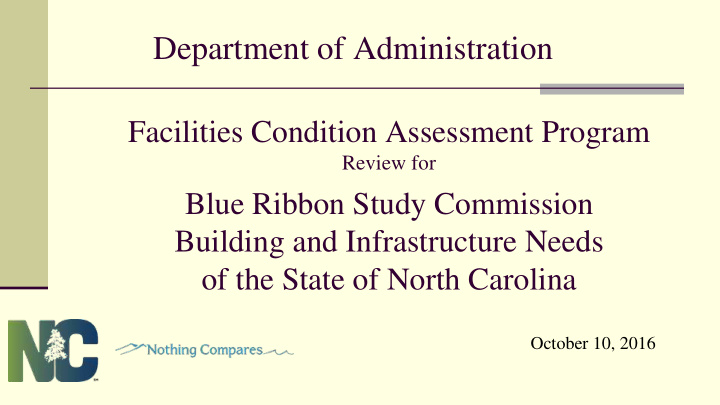



Department of Administration Facilities Condition Assessment Program Review for Blue Ribbon Study Commission Building and Infrastructure Needs of the State of North Carolina October 10, 2016
Facilities Condition Assessment Program §143-64.12 (B, B1, H, I) Responsible for reviewing the condition of state owned facilities and the preparation of Facility Condition Assessment Reports with prioritized recommendations and estimated costs for the correction of deficiencies. First step of OC-25 Cost Estimate submitted by Owners for funding and Design Contracts. FCAP data is now used to apportion Repair and Renovation funds for the UNC System. G.S. 143C-8-4 requires “each proposed repair and renovation expenditure shall be justified by reference to the Facility Condition Assessment Program (FCAP) operated by the Office of State Construction.”
§ 143C-8-4. Agency capital improvement needs estimates Repairs and Renovations Needs Estimate. - The first part of the capital improvement needs estimates shall include only requirements for repairs and renovations necessary to maintain the existing use of existing facilities. Each proposed repair and renovation expenditure shall be justified by reference to the Facilities Condition Assessment Program operated by the Office of State Construction.
Facilities Condition Assessment Program State’s facility inventory consists of approximately 12,000 total buildings. The smallest building is the Sentry Post at Tryon Palace at 9 square feet. The largest is at the Global Transpark listed at 600,000 sf. The inventory of facilities comprises 118,145,712 total sf. The approximate insurable value, as listed by the State Property Office, is $25.6 Billion Dollars. FCAP assesses all State-owned property of 3,000 sf & larger, which constitutes a total of 4,347 buildings out of the total 12,000 State facilities. This represents 36% of the facilities that the State owns. However, the square footage of the buildings assessed totals 113,464,000 sf which represents 96% of the total square feet and 95% of the total insurable value of all State owned facilities.
FCAP vital statistics By the numbers ……. The State of NC owns: 4347 buildings > 3000 square feet 99 counties 113,464,000 square feet Facilities Condition Assessment Program
FCAP History FCAP began in 1989 with Senate Bill 181 At that time the State owned 72,738,000 sq. ft. Two (2) FCAP “travelling teams” were established: Each 3 person team: Architect or Civil Engineer Electrical Engineer Mechanical Engineer Approximate 5 year cycle to cover entire state
FCAP History 2009: Due to state-wide budget constraints and a total travel ban the FCAP program was discontinued. Through retirements, reduction-in-force, and re-assignments to fill vacancies, the FCAP teams disbanded. 2010: SCO FCAP Manager position eliminated.
FCAP History September 2013: FCAP re- established with “all hands on deck” total SCO participation in a State -wide building assessment. One (1) permanent FCAP team reconstituted. May 2014: FCAP placed under SCO Assistant Director for Construction Administration. April 2016: Second permanent FCAP team established through re-assignment of existing personnel.
FCAP current statistics For the current 5 year cycle As of October 1, 2016: 86 Counties complete. 72,414,559 square feet inspected 2944 buildings 8095 deficiencies identified Documented with estimates and digital photographs $2.6 Billion in total deficiencies Agencies + Universities All Priorities (now out to 6 years) All Funding Sources (Appropriated & Self-Liquidating)
Total FCAP deficiencies by Department Priority Now, 1 year, 2 years Agriculture & Consumer Services: $22,775,850 Environmental Quality* : $3,526,050 Health & Human Services: $321,526,580 Justice: $18,949,500 Natural & Cultural Resources*: $60,476,500 Public Instruction: $39,472,525 Public Safety: $308,703,400 Transportation: $68,398,552 Wildlife Resources Commission: $4,914,900 Department of Administration: $232,280,000
Remaining FCAP Counties Current 5 year cycle began September 2013
FCAP Reporting Format Existing format: Deficiency Priority: Now 1 year 2 year 3 years 4 years 5 years 6 years Seven (7) different priority rankings
Existing Report Format Deficiency Priority: Now $1,370,000,000 1 year $281,000,000 2 year $265,000,000 3 years $180,000,000 4 years $127,000,000 5 years $116,000,000 6 years $264,000,000 Total: $2.6 Billion
Proposed Reporting Format Deficiency Priority: Life Safety $ Accessibility $ Critical $ Targeted Renovation $
Proposed Reporting Format Deficiency Priority: Life Safety Notified of Emergency, visibility to egress, can get out Hazardous conditions, Mold, Asbestos, Ventilation Accessibility Still not in compliance with 1991 ADA – Liability implications Critical If not repaired, significant building damage will result Targeted Renovation Major renovation due to age, condition, re-purpose
Sample future format Deficiency Priority: Life Safety ~$190,000,000 Feasible numbers Accessibility ~$220,000,000 Critical ~$340,000,000 Targeted Renovation ~$1,780,000,000 These are PROJECTED sample numbers
Recommend
More recommend